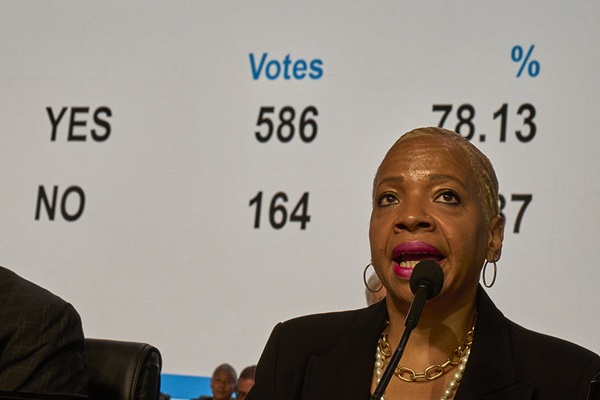Much like the United States, The United Methodist Church is governed by a written constitution. This document outlines how the denomination is to be organized while also defining the powers of the General Conference, the episcopacy and the Judicial Council. The Constitution is universally-binding to all United Methodist conferences (annual, jurisdiction and central) and entities worldwide. The Constitution can be found in Part I of the United Methodist Book of Discipline.
Just like most constitutions, this document can be amended in order to meet the changing needs of the denomination and its ministries. Constitutional amendments can originate from either the General Conference, annual conferences or jurisdictional/central conferences. All constitutional amendments (regardless of where they originate) must be voted on by General Conference and ratified by annual conferences. Here is what that process looks like:
Proposing an amendment to General Conference
A constitutional amendment can be proposed by anyone within The UMC. Some petitions may be drafted and submitted by bodies or institutions within the denomination, such as general agencies or annual conferences, while others may originate from the grassroots level.
- Worldwide Regionalization
- Racial Justice (¶5)
- Include 'gender' and 'ability' (¶4)
- Edit of the educational requirements for voting privileges to elect clergy delegates to General Conference (¶35)
Petitions to change the Constitution will be considered by the appropriate legislative committee made up of various delegates to the General Conference. A committee will vote on whether or not to submit the proposal to the full Conference for consideration. They can also amend the petition in committee. Even if the committee votes not to submit the petition, any delegate can present a motion to consider the amendment from the floor at General Conference. Once a petition is presented from the floor, the delegates may debate it, giving equal opportunity to voices in favor and against the amendment to be heard. Delegates can also propose changes to the amendment from the floor, which have to be voted on ahead of the amendment itself.
Once the conference votes to end debate on the amendment it is voted on by all of the delegates present. A constitutional amendment requires a 2/3 majority of the delegates in order to pass, unlike other proposed changes to the Book of Discipline, which only require a simple majority. If the amendment passes with the necessary 2/3 vote it will go before the annual conferences for ratification.
Annual conference ratification
After a constitutional amendment passes at the General Conference it can be presented to gathered annual conferences for ratification. The annual conference delegates (both clergy and lay) will vote on whether to ratify the amendment. The number of Yes and No votes are recorded and sent to the Council of Bishops, who keep track of all of the recorded votes from each conference. Annual conference delegates can debate the constitutional amendment according to the same rules as General Conference, but they are not allowed to amend it.
In order to become fully ratified, a constitutional amendment must have “a two-thirds affirmative vote of the aggregate number of members”[1]. This means the amendment has to be affirmed by 2/3 of all the delegates who have voted across the different annual conferences. Even if a majority of the annual conferences voted in favor of amendment, if it fails to garner the support of 2/3 of the total number of votes, it will not become church law. Changes to the 1st or 2nd Restrictive Rules in the Constitution require a 3/4 aggregate vote to be ratified. The Council of Bishops will announce when an amendment has met the necessary 2/3 majority of votes, at which point it officially becomes church law.
Additional resources
- Video: How is the United Methodist Constitution amended?
- 2016 UMC Book of Discipline (Cokesbury)
- Glossary: The Constitution
- ¶101. General Book of Discipline
- What is ... the General Conference?
- Exploring General Conference course
- Effective dates for General Conference legislation
This content was produced by umc.org on May 22, 2024. Philip J. Brooks is a writer and content developer at United Methodist Communications. Contact him by email.
[1] "The Book of Discipline of The United Methodist Church 2016.” ¶59





